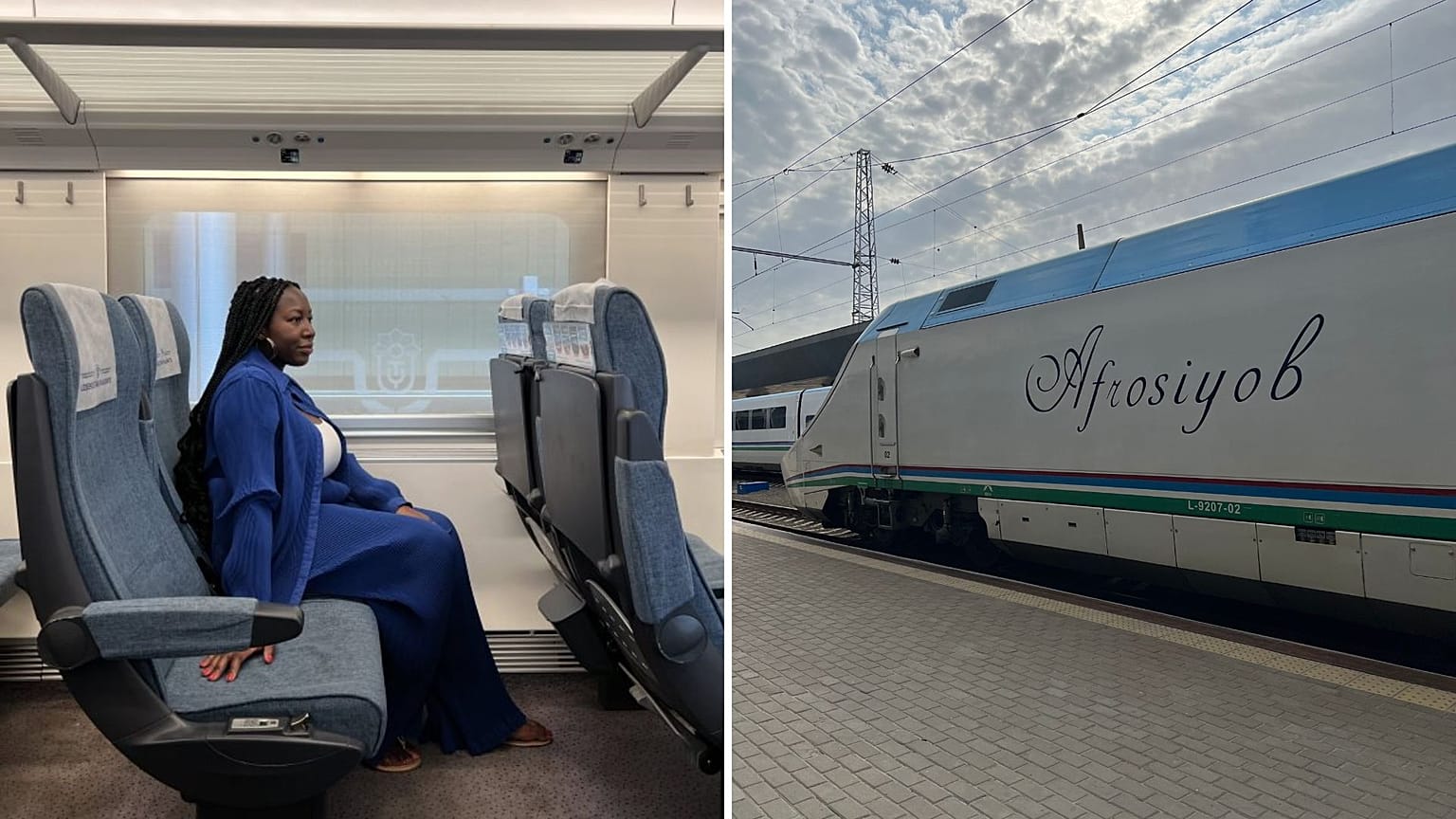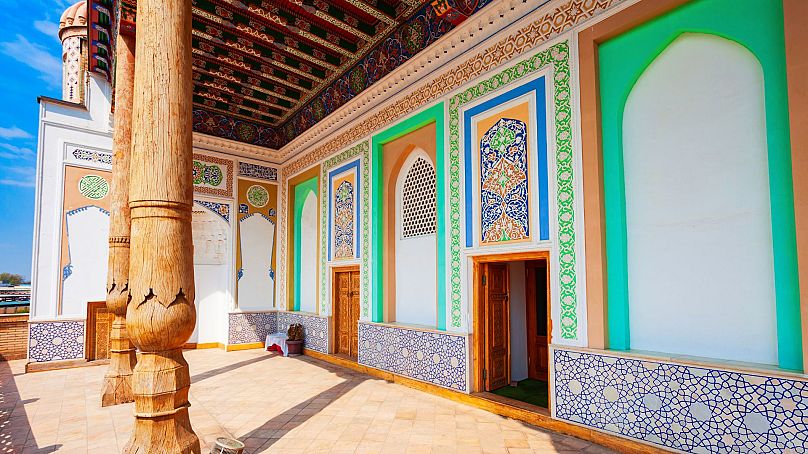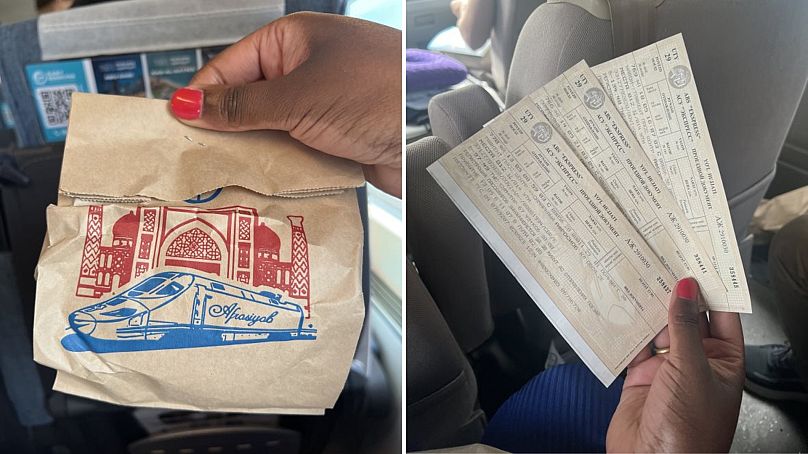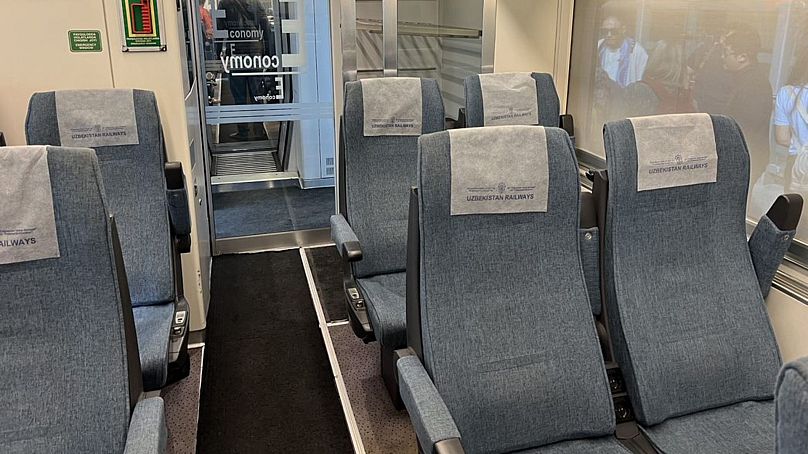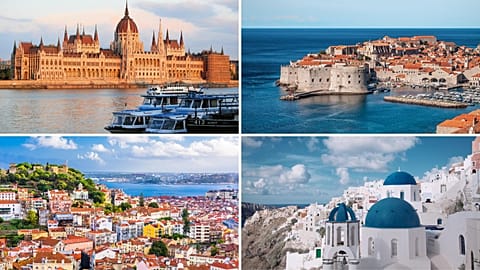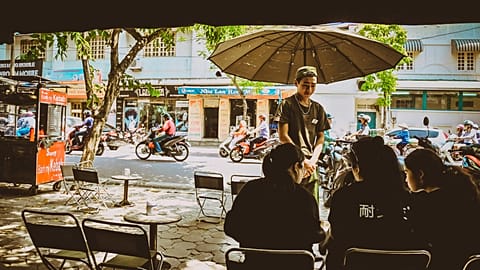I slashed my journey times by 60% on Uzbekistan's high-speed trains.
Uzbekistan is well known for its Silk Road trade routes and historic architecture, especially in large cities Tashkent, Samarkand and Bukhara - which are all connected by one high-speed train route.
Uzbekistan’s premier train, Afrosiyob, wasn’t just a sustainable way for me to travel within the country but also the most efficient: my journey from Tashkent to Samarkand was completed in just two hours instead of five by road. What would be a 9.5-hour car journey between Tashkent and Bukhara can be shortened to just under four hours too.
As I stepped onto the white train decorated with blue and green stripes, I handed my paper ticket to the conductor who guided me on board.
The train is split into three classes: VIP, business and economy. Finding my way to the economy class, I stowed my luggage away in one of the many available compartments and settled into my denim-coloured seat (or leather if you’re feeling fancy with a VIP ticket). The seat was surprisingly spacious, comfortable and perfect for dozing off.
The carriage was perfectly clean, and the air conditioning provided a break from the blazing sun as we embarked on our journey to Samarkand, passing by the lush green countryside and valleys along the way.
What cities does the Afrosiyob high-speed train pass through?
The rail routes for the Afrosiyob remain quite limited outside of larger cities. It conveniently connects Tashkent, Samarkand, Navoi and ends in Bukhara, allowing you to visit the major historical and cultural attractions with ease.
Along the journey, popular tourist sights include the bustling Chorsu Bazaar in Tashkent, the mosaiced Hazrat Khizr mosque in Samarkand and the historic Chor Minor - the madrasah of four minarets - in Bukhara.
It’s worth pointing out that Afrosiyob’s departure times are limited since there are only a few trains available daily. So if you want greater flexibility or to cover smaller cities and regions, a slower train (that still departs daily) might be a better option for you.
What can you eat on the Afrosiyob?
As my journey progressed, a food cart made its way through the carriages offering a variety of snacks like chocolate, crisps, nuts, juice and water to buy. The treats are slightly more expensive on board compared to outside the train stations, so it’s worth stocking up beforehand if you know you’ll get peckish.
About 20 minutes later, another cart made its way through, giving us a lovely surprise: a complimentary light breakfast made up of a croissant, muffin and a coffee sachet. The train staff carefully poured hot water for anyone who wanted to prepare their coffee. In my cosy seat, equipped with a pull-down tray table, I enjoyed my breakfast goodies while taking in the scenic views passing by.
Travelling while Black in Uzbekistan
For train lovers, travelling within Uzbekistan can be comfortable, enjoyable and convenient. However, it’s essential to address some experiences I encountered on the Afrosiyob as a Black woman.
Throughout my train journeys, I faced challenges that other Black travellers should be aware of. Local passengers on the train continuously stared at me and attempted to film me without my consent. Some individuals sent their children to take pictures of me.
In one instance, an Uzbek man invaded my personal space and shouted “Serena Williams” at me. On the train platforms, people were telling people to move so they could try and take my picture without asking.
It’s unfortunate to have experienced this distressing situation - which repeatedly happened on and off the train. If you are a Black traveller and choose to visit Uzbekistan, it’s important to be aware of the challenges you will likely encounter.
While the train experience itself was comfortable, these incidents served as a stark reminder of our realities.
How do I book tickets for Uzbekistan’s high-speed train?
The Afrosiyob is very popular and due to the limited number of trains, you should always book your tickets in advance.
If you plan to travel during the peak season from April to June, you should aim to secure your tickets a month ahead of time. Even during the low season, it’s still a good idea to buy your ticket at least a week in advance to make sure a seat is available.
Prices vary depending on the class and route. For an economy seat from Tashkent to Samarkand, you’ll spend around €8, while Business is €11 and VIP class is €16. For the journey from Tashkent to Bukhara, it costs around €14 for economy, €19 for business and €26 for VIP.
You can reserve your spot online at 'eticket.railway.uz' - the page will initially be in Russian but you can switch to English. Once you’ve made your booking, you’ll receive a QR code to show on your phone to validate, along with your passport.
Another option is to visit the ticket office at the train station and book in person with a cash or card payment. You get a printed ticket this way. If you know the number of stops you plan to make, you can buy all of your tickets in one go to avoid any potential issues with availability. You’ll still need to show your passport with a printed ticket.
If you’re looking for a more affordable option, consider booking a spot on the slower Sharq train, which is about half the price of the Afrosiyob. Or there is the overnight sleeper train for a different type of travel.















